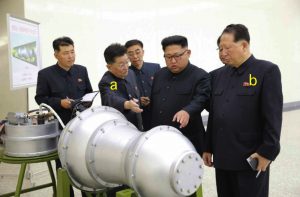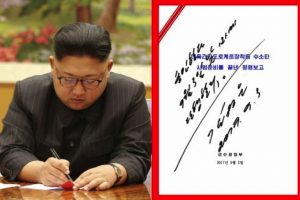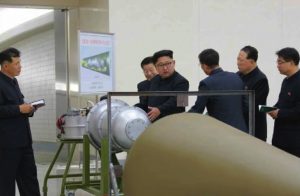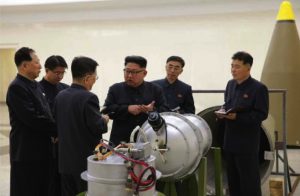DPRK Conducts 6th Nuclear Test

Kim Jong Un is briefed about a nuclear device during a visit to a facility of the Nuclear Weapons Institute. Also in attendance, tagged, are Nuclear Weapons Institute head Ri Hong Sop [a] and WPK Munitions Industry Department Deputy Director Hong Sung Mu [b] (Photo: Rodong Sinmun).
Scientists in the nuclear field of the DPRK successfully carried out a test of H-bomb for ICBM in the northern nuclear test ground of the DPRK at 12:00 on September 3, true to the Workers’ Party of Korea’s plan for building a strategic nuclear force.
The H-bomb test was carried out to examine and confirm the accuracy and credibility of the power control technology and internal structural design newly introduced into manufacturing H-bomb to be placed at the payload of the ICBM.
The result of the experimental measurements showed that the power specifications of nuclear warhead including total explosion power and fission to fusion power rate and all other physical specifications reflecting the qualitative level of two-stage thermo-nuclear weapon fully complied with design figures. It was also confirmed that even though the recent test was carried out with the bomb of unprecedentedly big power, there were neither emission through ground surface nor leakage of radioactive materials nor did it have any adverse impact on the surrounding ecological environment.
The test re-confirmed the precision of the compression technology and the fission chain reaction start control technology of the first system of the H-bomb and proved once again that the nuclear material utility rate in the first system and the second system reached the levels reflected in the design.
Symmetrical compression of nuclear charge, its fission detonation and high-temperature nuclear fusion ignition, and the ensuing rapidly boosting fission-fusion reactions, which are key technologies for enhancing the nuclear fusion power of the second-system of the H-bomb, were confirmed to have been realized on a high level. This helped prove that the directional combination structure and multi-layer radiation explosion-proof structural design of the first system and the second system used for the manufacture of the H-bomb were very accurate and the light thermal radiation-resisting materials and neutron-resisting materials were rationally selected.
The test helped draw the conclusion that the Korean-style analytic method and calculation programs for the complicated physical processes occurring in the first and second systems were put on the high level and that the engineering structure of the H-bomb as a nuclear warhead designed on the Chuch’e basis including the structure of the nuclear charge of the second system was creditable.
The test once again confirmed the reliability of the concentration-type nuke detonation control system fully verified through a nuclear warhead detonation test and test-launches of various ballistic rockets.
The perfect success in the test of the H-bomb for ICBM clearly proved that the Chuch’e-based nukes of the DPRK have been put on a highly precise basis, the creditability of the operation of the nuclear warhead is fully guaranteed and the design and production technology of nuclear weapons of the DPRK has been put on a high level to adjust its destructive power in consideration of the targets and purposes. It also marked a very significant occasion in attaining the final goal of completing the state nuclear force.

Kim Jong Un meets with the members of the WPK Political Bureau Presidium on September 3, 2017 in central Pyongyang: SPA Presidium President Kim Yong Nam [a], DPRK Premier Pak Pong Ju [b], WPK Vice Chairman Choe Ryong Hae [c] and KPA General Political Department Director VMar Hwang Pyong So [d] (Photo: Rodong Sinmun).
A report was delivered to the Presidium “about the study on nuclear weaponization made by the Nuclear Weapons Institute of the DPRK, and discussed the issue of conducting test of H-bomb for ICBM as part of the efforts to attain the final goal of completing the state nuclear force set forth at the 7th Congress of the WPK.” The Political Bureau Presidium passed a decision “on carrying out a test of an H-bomb for the ICBM as part of efforts to attain the final goal of completing the state nuclear test” Kim Jong Un (Kim Cho’ng-u’n) signed this as the order for the sixth nuclear test.
The Political Bureau Presidium also discussed “ways and measures for containing the US and other hostile forces’ vicious moves for sanctions against the DPRK and for making tasks of different fields set forth at the 7th Congress of the WPK be implemented with success.”

Kim Jong Un signing the authorization for the sixth nuclear test following a meeting of the WPK Political Bureau Presidium on the morning of September 3, 2017 (Photo: Rodong Sinmun).

(Photo: Rodong Sinmun)
On the morning of September 2 (Saturday), Kim Jong Un visited a device assembly facility under the Nuclear Weapons Institute [NWI]. Also among those in attendance were Nuclear Weapons Institute chief Ri Hong Sop (Ro Hu’ng-sop) and WPK Munitions Industry Department Deputy Director Hong Sung Mu (Hong Su’ng-mu). According to state media the NWI “recently succeeded in making a more developed nuke, true to the strategic intention of the WPK for bringing about a signal turn in nuclear weaponization.”
Jong Un watched a nuclear device loaded into a ballistic missile and said that he “felt the pride of indomitably bolstering up the nuclear forces at a great price while seeing the Chuch’e-oriented thermonuclear weapon with super explosive power made by our own efforts and technology” and expressed “great satisfaction over the fact that our scientists do anything without fail if the party is determined to do.”

(Photo: Rodong Sinmun)
Jong Un “acquainted himself with technical specifications and structural and operational characters of the H-bomb” and that “scientists further upgraded its technical performance at a higher ultra-modern level on the basis of precious successes made in the first H-bomb test.The H-bomb, the explosive power of which is adjustable from tens kiloton to hundreds kiloton, is a multi-functional thermonuclear nuke with great destructive power which can be detonated even at high altitudes for super-powerful EMP attack according to strategic goals.”
Kim Jong Un remarked that “all components of the H-bomb were homemade and all the processes ranging from the production of weapons-grade nuclear materials to precision processing of components and their assembling were put on the Chuch’e basis, thus enabling the country to produce powerful nuclear weapons as many as it wants.” He noted that “the scientists, technicians, workers, soldiers and officials in the atomic power industry, who have made devoted efforts to raising the level of nuclear weaponization up to its perfection as intended by the Party, are creditable ‘nuclear combatants’ of the Party who are upholding its line of simultaneously developing the two fronts with the strongest nukes.”
Jong Un “highly praised their exploits.” After underscoring “the need for the institute to dynamically conduct the campaign for successfully concluding the final-stage research and development for perfecting the state nuclear force” he issued “important tasks to be fulfilled in the research into nukes.”